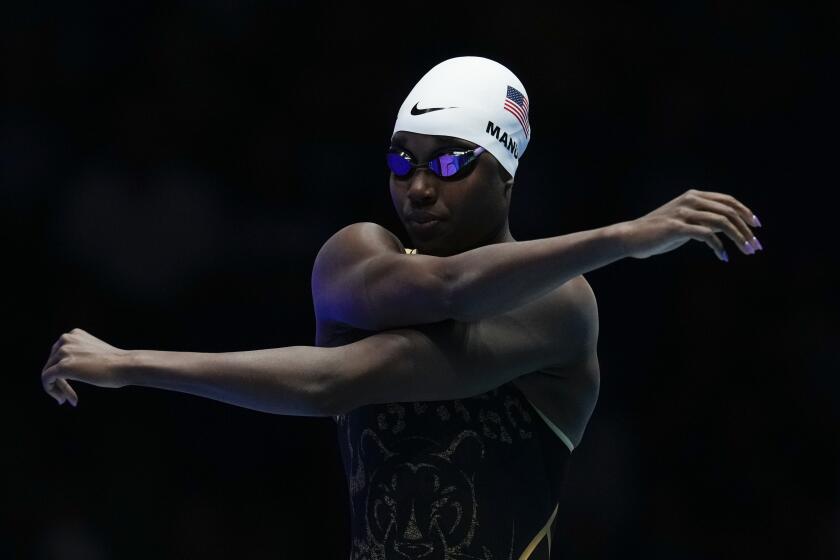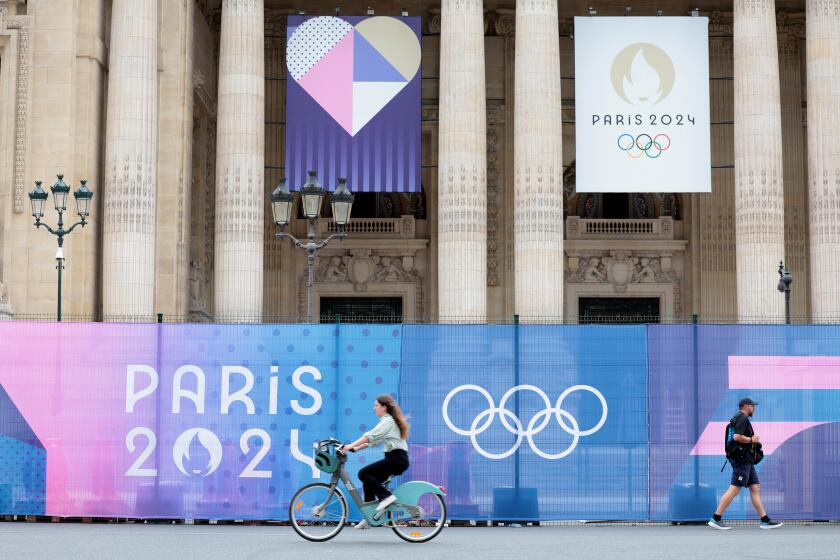THE AGONY OF DEFEAT : INTRODUCING: GABRIELE, MS. MISHAP : It Seems Andersen-Schiess, of Marathon Fame, Is an Accident Waiting to Happen
In Switzerland, where learning to ski is practically the birthright of every child, Yurg Schiess gave his daughter Gabriele her first pair of skis when she was four years old. These were special skis. They turned out to be survivors, just like her parents--and just as she was going to be, over and over again.
Indeed, it had been only a year before Gabriele’s birth that the Swiss-born Schiess and his German wife, Ursula, had fled the second World War to return to his homeland. They had been living for several years in Austria and Germany, where Schiess worked as a metallurgist. By 1944, however, the war drove Schiess from Leipzig, and he took his wife and two children back to Switzerland.
Gabriele remembers stories her parents told her about living in Germany during the war, of how they would hide in the cellar of their apartment building during the Allied bombing attacks and run upstairs after the noise had stopped to put out the fires.
The wooden skis, badly scorched in one of those raids, were among the few belongings Gabriele’s parents were able to take with them on escape from Germany. When her father thought Gabriele was old enough, he found the skis and cut off the burned tips. They not only had survived. They were just the right size.
For the young Gabriele, it was the first lesson in how hardship could be transformed into something positive. But it was not to be the last.
Gabriele Andersen-Schiess, who turned 40 in March, is no stranger to adversity, as the millions who viewed the first women’s Olympic marathon last summer already know. In one of the most searing images of the 1984 Games, Gabriele--competing for Switzerland--struggled through the last 500 meters of the race suffering the grotesque effects of heat exhaustion. Her face slack, her body twisted, she lurched around the coliseum track, moving away from officials who offered to help her.
It was a painful scene that few will forget. The mail still arrives at her home in Ketchum, Idaho, long after the Games have ended. People talk about her courage, her iron-willed determination to finish and her close call from possible brain damage, even death.
But this was not an incident born of inexperience, nor the case of someone trying to run beyond her limits. Gabriele Andersen-Schiess is no novice--she has run more than 20 marathons, including a personal best of 2:33:25 in Sacramento in 1983 and a first-place finish in 1982 in the grueling Pikes Peak Marathon.
And she will tell you casually--and disarmingly--that her life has been filled with moments like this, that it has always had adventures and misadventures, accidents and close calls--all for her love of sports. She does not believe an occasional flirtation with danger is too high a price to pay for having fun doing the things she loves. Her roguish face, tanned from months of skiing and running in the rugged Idaho winter, wears a puzzled expression. How can you enjoy life if you don’t take a chance now and then?
“Sometimes there are times when I’m scared,” she says. “But I just try to overcome my fear. Mentally, I have a certain toughness. I don’t let things discourage me. I’m not afraid of death. I’d rather die doing something I enjoy than get old and senile and become an invalid. I think it’s all just fate.”
Some might call her foolhardy, even reckless. But she trains arduously and competes with the talent and vigor of a woman half her age. It’s just that she has this tendency to get into trouble. And not just in the Olympics, as we will shortly see.
“I knew I had to stay within the orange cones, but I just couldn’t walk straight,” she says, recalling her final torturous minutes in the Olympic marathon. “I knew what I wanted to do, but my muscles wouldn’t respond anymore. It’s hard to accept when your mind wants to do something, but your body says no.”
Had the doctors pulled her off the track, she says she probably would have gone with them, but only because she was too weak to resist. She is happy they allowed her to finish.
“Look at how quickly I recovered,” she says. “I remember thinking when I came out of the tunnel into the stadium: I’ve gotten this far. I’m going to crawl, if I have to, to finish.
“I just didn’t want to give up. Two years ago, I never thought I’d be in the Olympics. And I may never have another opportunity. It was something very special for me, much more so than for the younger runners.”
She stands in the kitchen of her open-beam cedarwood house, a gleaming snow-covered mountain looming behind her backyard. She and her 38-year-old husband, Dick Andersen, live in Ketchum, a historic mining and sheepherding town where Ernest Hemingway is buried. Dick, a warm-featured man with thinning red hair and a matching moustache, is assistant manager of the Sun Valley resort where Gabriele teaches skiing.
For someone such as Gabriele, who loves cross-country and downhill skiing, swimming, cycling and riding horses, this environment, on the edge of the Sawtooth wilderness area, is almost idyllic. Almost , because the winters here are tenacious and hang on until April. Thus, if you are also a serious competitive runner, speed work and long runs on snow and in sub-zero temperatures and at an altitude of 6,000 feet can be tough.
Gabriele Andersen-Schiess, at 5-feet 4-inches and 110 pounds, is much tinier than she appeared during the Games. A citizen of both Switzerland and the United States, she still speaks with a strong accent. Since the subtleties of American jokes sometimes elude her, she is often teased about having no sense of humor. And occasionally, to Dick’s amusement, she confuses her syntax.
It is late morning and she has just returned from the first of two daily workouts. She is training for the Osaka Women’s Marathon in Japan. (She would take fifth place with a 2:37:17.) She will run it three months after the New York City Marathon, where the conditions were far worse than in L.A. The temperature hit a high of 74 degrees, with 96% humidity. In that marathon, her first after the Olympics, she ran a controlled race and finished eleventh for women in 2:42:24. She was not happy with her performance.
“I knew I had to be really careful,” she says. “I just could not let it happen again. I stopped every mile for water and I did not run as competitively as I wanted to. I saw a girl in front of me and wanted to catch her--but I didn’t try.”
This attitude was a departure for her. Rarely does she hold back.
Four years ago, when she was 36, she came in second--easily beating women in their twenties--in NBC Sportsworld ‘s “Survival of the Fittest,” an aptly named competition that takes several days in the Sierra Nevadas. The events included a rock climb and rappel (white-water swim and kayak in the Stanislaus River), a rope climb, a balance walk on a suspended rope and a zip line. The final race is a “survival run” down the side of a steep cliff into a swiftly moving river current, followed by a climb up a cargo net to a “Tarzan swing” from a rope back into the water, ending with a quarter-mile run in soft sand to the finish line.
“I’m very athletic, I love sports,” she says. “Some people would just maybe give up and not do these things. Well, I don’t like to quit anything if the going gets tough. I just like to hold in there.”
Her husband is listening. “She’s fearless,” he says. “Fearless to the point where it’s almost scary. Anything that’s risky, she loves to try.”
Try, indeed. A description of the “bad things” that have already happened to her, one by one, each in harrowing, spine-tingling detail, make her Olympic experience look like a stubbed toe.
In 1967, in Switzerland, she was thrown off a horse and broke her collarbone.
“I was really discouraged,” she says. “I wanted to give up, but I just couldn’t.”
Four years later, also in Switzerland, she was riding bareback down a narrow trail in the woods. The horse shied, she slid off and hit a tree--head first. Unconscious, she rolled down the side of the trail into a little creek and woke up on her back. “That was fortunate,” she says. “If I’d been face-down, I would have drowned.” She had a broken nose and a mild concussion.
One morning in 1976, she and Dick, in Minneapolis at Christmas to visit Dick’s sister, decided to go for a run. The temperature was 11 degrees below zero, the wind was howling. They could not even see where they were going.
“After 30 minutes, I turned back to the motel, but Gaby kept going,” Dick says. “When she didn’t come back for more than an hour and a half, I started to worry.”
Eventually, there was a feeble knock on the door. There stood Gabriele--a human ice sculpture. Unknowingly, she had run from the roads onto the top of a frozen river and had fallen through. Fortunately, the water was only waist-high. Drenched, she managed to get herself out and run back to the motel. But it was so cold, her water-laden clothes froze along the way.
Dick immediately stuck her in a shower to thaw her out. “If that water had been a foot deeper, she would still be there,” he says.
In July, 1979, while riding in Stanley, Idaho, Dick’s horse cleared a ditch, but Gabriele’s stumbled. She slid off when the horse fell. As the horse attempted to get up, his hooves flailed and hit her in the face. She was knocked out again.
Gabriele lay there, her body quivering, her husband really panic-stricken this time.
“I thought she was dead,” he says. Finally, she got up, walked around and mounted the horse again. Her only legacy was two black eyes.
In February, 1981, she entered a downhill ski race in Sun Valley. This was no ordinary downhill race. This was a downhill race on cross-country skis. Cross-country skis are longer and skinnier than alpine skis and provide much less control, creating frightening speeds of up to 60 miles an hour. You need at least 100 yards to stop. In 1980, she was second.
“In 1981, I was going for the win,” she says.
She was streaking down the hill in perfect control, when another skier missed a gate and decided to climb back up. There was only one problem. He was climbing back up directly in her path. She hit him hard. Knocked unconscious, she lay sprawled in the line of other racers and was saved only by the quick action of a member of the ski patrol, who dived on top of her body. When it was safe, he pulled her away. Carried down on a stretcher, she woke up later that day in the hospital with a sore head, nothing more.
By far her worst accident occurred in May, 1981, in the Grand Canyon, on the second day of a Colorado River kayak trip. It was a nice, sunny day, and she and her companions went ashore for lunch. She wandered away alone to explore and began climbing a cliff.
“When I reached the top, there were several big boulders and little cliffs,” she says. “I was standing too close to the edge and didn’t notice. I made a step backwards . . . “
She tumbled about 30 feet. “I remember turning my head as I fell, looking to see what was coming up,” she says. “I didn’t see a meadow. I saw a pile of rocks.”
No one saw her fall. When she came to, her back was in agony and her left wrist was twisted. In terrible pain, she crawled on her knees to a point where she could see her companions below. She screamed for help. Two of the men in her party were doctors. They had a first-aid kit containing pain killers. This was fortunate. It was two days before a helicopter spotted them and brought her out.
She had two compression fractures in her upper back and a shattered left wrist. The bones in her back eventually healed with no lingering problems, but her wrist has never been the same. A pin used to set it caused an infection. It still hurts and she has no range of motion.
This accident, she says, is probably what most turned her to running.
Five weeks after the 1981 accident, wearing a cast, she began to jog.
“My hand was no good and I couldn’t do much skiing, so I kept running more,” says Gabriele. “By spring, some friends decided to run Pikes Peak. I hadn’t run any marathons for several years, so I decided to do it.”
She won.
Then, in May, 1983, without speed work, she ran a 2:43:44 in Boise’s Great Potato Marathon and qualified for the U.S. women’s Olympic marathon Trial. After that, her training became more sophisticated as she incorporated more speed workouts into her overall program.
It paid off. In San Francisco in August, she lowered her best time to 2:38:15. In October, it dropped another two minutes when she clocked 2:36:22 in the Twin Cities Marathon, collecting $12,000 as first woman.
By then, she had been contacted by Swiss Olympic officials about the possibility of running for her native country in the Games. But they told her she must run under 2:37. She did it the following December, running 2:33:25 in the California International Marathon in Sacramento, still her personal record. With a spot on the Swiss team and scant chance of making the U.S. team, she chose not to run the U.S. Trial. In L.A. she was the only woman marathoner on the Swiss team.
Gabriele thinks it unlikely she will run in another Olympics. As for American masters records, she is easily within reach of Miki Gorman’s 2:39:11 marathon record. Also, with a 10K best time of 33:29, she has a shot at Cindy Dalrymple’s 34:29.
Initially, Gabriele was embarrassed and uncomfortable by the attention paid to the Olympic incident. But then she began to read about how she probably would be in great demand by race organizers as a result of the publicity. Her expectations rose, only to be dashed when little happened.
“It makes me a little mad because they said, ‘She’s going to have it made,’ ” she says. “It just wasn’t so. New York was the only one that offered me money to come. Still, I don’t want to be invited to run because I had a bad performance, but because I’ve had good ones. Every marathoner has bad luck. I just had the bad luck to be on public display.”
On the morning of the Olympic marathon, Dick followed the women on a moped and last saw his wife at the 20-mile mark. She appeared to be gaining on some of the other runners. She knows she is not good in the heat--it had troubled her once before during a 10K race in Salt Lake City--but there were no signs of trouble, not yet anyway. Dick thought she looked fine.
He hurried back to the stadium, propped his moped against a tree and ran to his seat. He expected her to appear sometime after the 15th runner.
“When I last saw her, she was behind Nanae Sasaki (of Japan, who finished 19th). When Sasaki came in, I said, ‘OK, get ready for Gaby.’ We got our cameras set to capture the big moment of Gabriele’s running career. We waited . . . and waited . . . and waited. I started getting nervous.”
Finally, Gabriele appeared. She was in 37th place and would collapse over the finish line in 2:48:12.
“I saw her, stooped over like that, swinging her arm, and said, ‘Oh my God,’ he says. “Then I realized, when she still had another lap to go: She’s going to finish this thing if it kills her. I knew her well enough. I knew she’d never quit. And then I got scared.”
Halfway around the world, 73-year-old Ursula Schiess sat in front of her television set in Zurich, crying. She immediately called Gabriele’s brother in Seattle. He, in turn, telephoned Swiss officials in Los Angeles and was able to find out later that his sister was all right.
While his wife was still staggering around the track, Dick was fighting his way out of the stands. He went from usher to usher, pleading to be allowed onto the infield. Eventually someone gave him access to the tunnel where he found Gaby on a stretcher.
“She was in a lot of pain,” he says.
He continues: “One interviewer asked if I fell in love with my wife all over again that day, and the answer is yes. It was the one point in my life where I truly admired her determination. Most of the time, it just frustrates me.”
Gabriele Andersen-Schiess’ husband and friends seem to have an uneasy truce with her reluctance to quit tempting fate.
“We’ll be out on the road running, and a car will be coming at us,” Dick says. “Everyone will move but Gaby. She waits until the last minute.”
One of her friends and running companions, Dr. Buck Levy, says, “She has no idea how to rest her body. It’s just not in her approach to life.”
Dick agrees. “You won’t ever slow her down,” he says. “You can’t worry about her. Otherwise, you’d be worrying all the time.”
On this particular evening, Gaby is off for a quick trip to the market in the middle of a snowstorm. She pulls her car out of the garage, onto the slick roadway. A visitor, noting that Gabriele does not wear a seat belt, suggests she might try it--especially in such treacherous weather.
She smiles. “I’ve never had a car accident,” she says. “That should tell you something.”
Marlene Cimons is a Washington Bureau reporter. This article appeared originally in the May issue of The Runner Magazine.
More to Read
Go beyond the scoreboard
Get the latest on L.A.'s teams in the daily Sports Report newsletter.
You may occasionally receive promotional content from the Los Angeles Times.





